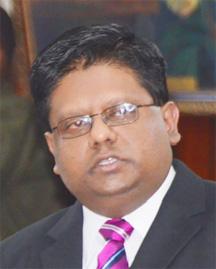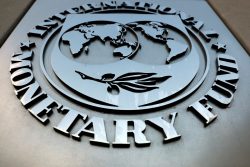Finance Minister Dr Ashni Singh on Wednesday told the annual CDB meeting that Guyana is aggressively diversifying its economy but he expressed concern at the decline in loans to members and called again for the bank to craft a viable strategy for Caribbean development.
In his capacity as Governor of the Caribbean Development Bank for Guyana, Singh said “For its contribution to the advances we have made as a Region over the past year, we are indebted to the Bank. In the same breath, given the considerable work that remains ahead of us as we confront the task of developing our countries and our Region, we will continue to look to the Bank and expect much of it, especially since for so many of us it is the sole or main source of development financing”.

In recent years, he said the Region has mirrored the multi-speed performance with Caribbean commodity exporters growing by 3.4 per cent in 2012 and projected to grow by 3.6 per cent this year. Tourism dependent Caribbean economies grew by 0.3 per cent in 2012 and are projected to grow by 1.2 per cent in 2013. “As I have stated elsewhere, this striking dichotomy is reflective of the under-diversification of our Region’s individual econo-mies and the under-integration of the regional economy as a whole. Until these failures are resolved, our Region’s vulnerability will remain chronic.”
Regarding the medium and long-term outlook for Guyana, Singh said that the country has embarked on an aggressive approach to accelerate economic diversification and build greater resilience, with significant returns emerging from these efforts. “Gone are the days when our heavy dependence on the traditional products, sugar, rice and bauxite, left our economic fortunes to the vagaries and vicissitudes of these industries. Today, buoyant activity in mineral exploration and extraction, agricultural diversification, information and communications technology, construction and financial services, and adventure tourism, all form the basis for a broader-based and more resilient Guyanese economy,” he said.
In addition, efforts are being made to move away from a dependence on fossil fuels to a reliance on hydropower to meet the needs of the national electricity grid with increased generation capacity, improved reliability and affordability.
This is being established within a framework in which Guyana’s vast and pristine standing forests can be and are remunerated for the global environmental services they provide.
Singh said as a result Guyana has recorded a seventh consecutive year of positive economic growth with real gross domestic product expanding by 4.8 per cent in 2012. The rice industry achieved its highest output ever produced in its history; the gold industry. Similarly, the gold industry achieved its highest output by small and medium-sized miners in the country’s history and strong positive growth was recorded in several other sectors.
“Export earnings increasing by 23.6 percent, foreign direct investment increased by 19 percent, and external reserves were maintained at 4 months of import cover. Credit by the banking system to the private sector grew by 20 percent, the weighted average lending rate of the commercial banks declined by 60 basis points, the exchange rate remained stable, and inflation was contained to 3.5 percent,” he said. Singh added that this strong performance is projected to continue through 2013 with growth projected at 5.3 per cent.
The minister also told the meeting that the progress Guyana made in strengthening the economy and in improving key social indicators is not accidental; rather it is the result of a deliberate policy stance “exercising responsible choices when confronted with testing policy options, sustained implementation in oftentimes challenging circumstances, and the strong support of our development partners.”
Physical
infrastructure
Regarding physical infrastructure, the CDB approved a US$34 million loan in 2012 to finance the rehabilitation of the West Coast Demerara road, a major highway linking large residential, commercial, and agricultural communities. Incidentally, this was the largest project approved by the Bank in 2012. Singh also noted that the US$16 million loan to finance improvement of community roads in several coastal villages is nearing completion.
Education
Dr Singh also said the completion and bringing into operation of two new Technical and Vocational Education Training (TVET) centres, under the US$7 million project in 2012 has already resulted in 390 young men and women starting training courses. At least 50 per cent of the participants will complete their training this year and immediately enter the workforce.
The minister also said the projects funded by grant resources administered by the Bank continue to be a critical component of Guyana’s financing portfolio, and the Basic Needs Trust Fund (BNTF) is foremost amongst these. The BNTF has supported projects in health, education, water and sanitation, infrastructure and skills training across the regions.
The Guyana governor also noted that the projects being implemented here with CDB support “are a manifestation of the unique position occupied by the Bank as the premier indigenous regional development institution, resourced with world class expertise in the practice of development.
With this in mind, he submitted that Guyana is concerned about the CDB’s operations across the entire spectrum of its membership, particularly the 38 per cent decline in gross loans, equity and guarantees approved, the 41 per cent decline in loan disbursements, and the 377 per cent reduction in net transfers resulting in a negative net transfer of resources to borrowing member countries for the first time since 2000. Guyana is equally concerned about the recent downgrading of the Bank’s credit rating and urged the directors and management to take every step to arrest it.
Singh also said the refocusing of the Bank’s energies to support the achievement of improved macroeconomic conditions in the borrowing member countries remains critical to ensuring that targeted poverty interventions have the intended effect. In this context, he reiterated the need for a viable and practical strategy for Caribbean development.
“The Bank is much more than a lending institution… it is a uniquely endowed regional repository of expertise especially on development matters,” the minister said, adding that it must be mobilised in aid of a more effective response by our Region to the thus far elusive quest for lasting development and prosperity.








